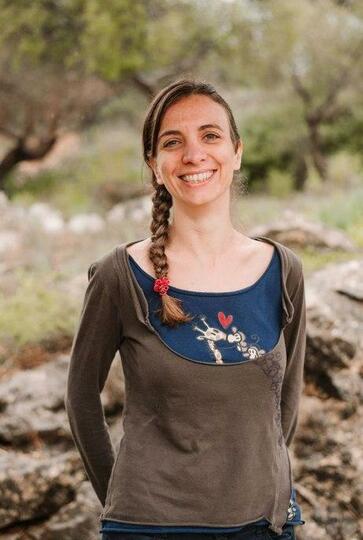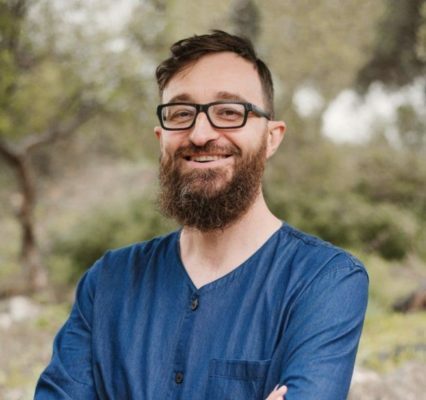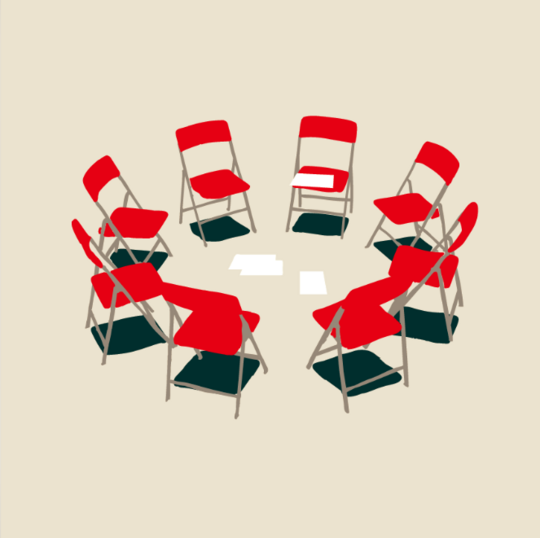Interviews
Katy Rubin Legislative Theatre looks at policy issues in the way that they're informed by power
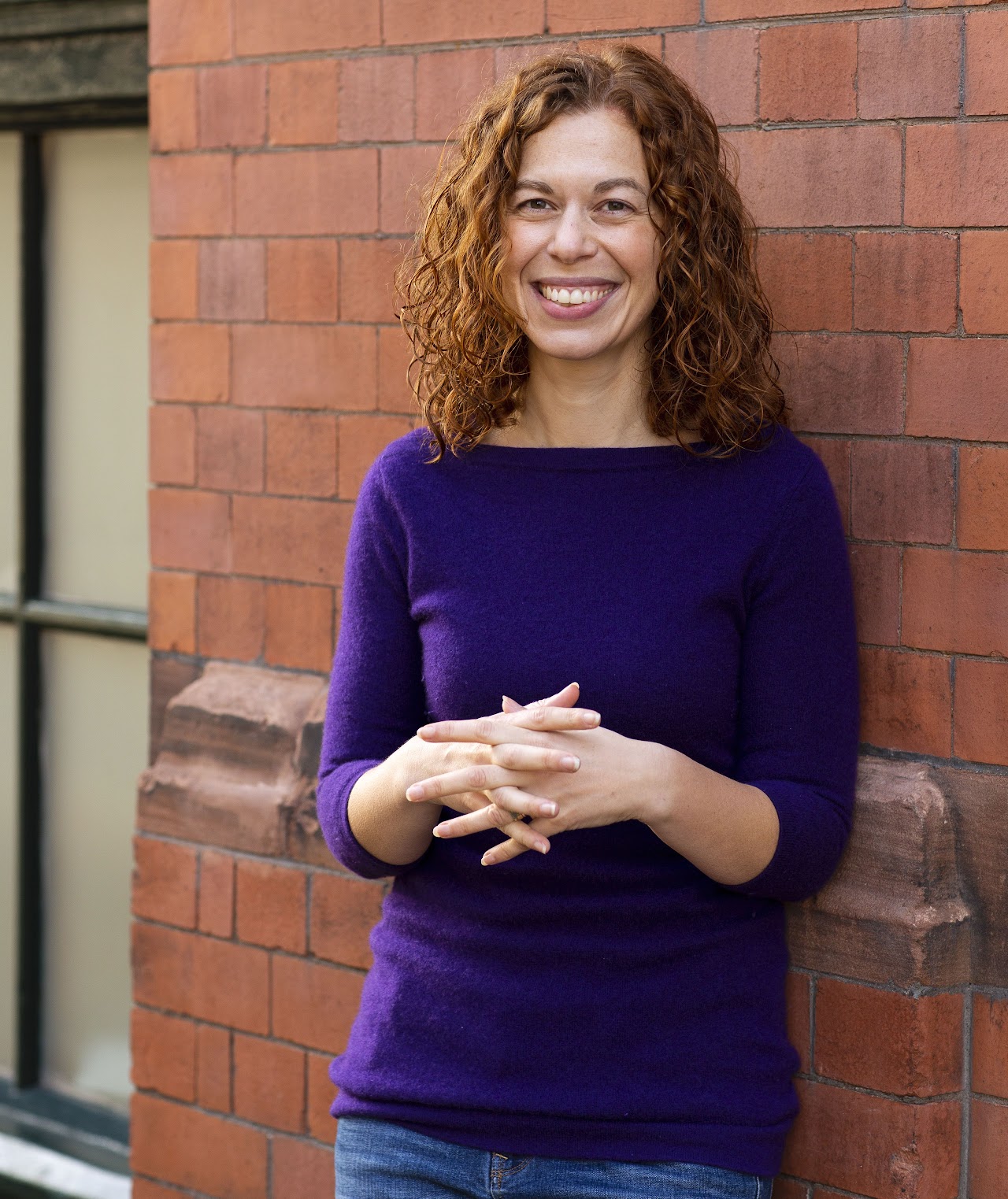
A conversation between Marta Anducas, Olivier Schulbaum and Katy Rubin, artist and civic change practitioner, working with cities across the UK and internationally to implement and advance Legislative Theatre.
In an article in the first edition of the journal, we declared ourselves learners of Freire’s wisdom. On this occasion, we continue to explore his legacy from another perspective: the stage. We raise the curtain to dive into the world of Legislative Theatre with Katy Rubin.
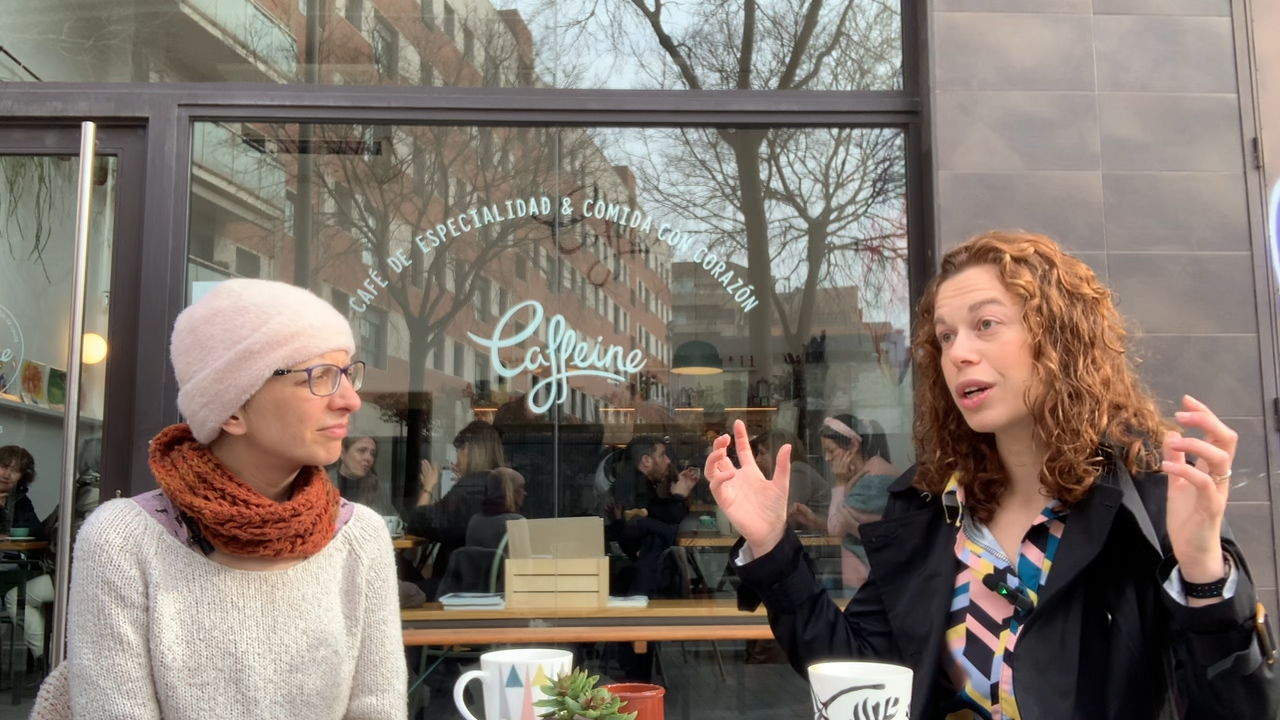
We met Katy Rubin in Barcelona, taking advantage of her visit to the city to share the potential of the Legislative Theatre in the UCLG retreat (United Cities and Local Governments).
In Legislative Theatre a community facing a problem makes a play. So, for example, what's our experience getting mental health support in schools for young people in Greater Manchester?
For an hour, we talked about Legislative Theatre (LT): from its origins, characteristics and potential, to the use case that has brought us together, the starting point of this report. We hope you enjoy and learn as much as we did from Katy Rubin’s sharing and wisdom.
Optimistic Minds & Mindset Revolution: LT in action
Katy Rubin’s path crosses ours thanks to the collaboration of Platoniq Foundation with the Mindset Revolution (MR) project. MR follows the development of Optimistic Minds, a project in which a group of diverse young people in Greater Manchester, supported by Katy, created a play to tell their experience of navigating an unresponsive mental health system.
In Legislative Theatre a community facing a problem makes a play. So, for example, what’s our experience getting mental health support in schools for young people in Greater Manchester? People come together, they play games, they tell stories, they identify shared experiences, they build a play, and they do participatory research around the process of making that play. The goal is to frame their human daily lived experience of the problem and understand some of the context, like the bureaucracy around the problem, and then reflect that bureaucracy in the play.
Mindset Revolution continues that experience by training young people as Legislative Theatre facilitators, as well as providing resources for young people to invent their own spaces of participation, from where they can help shape youth mental health policies and change how services are delivered.
Young people and mental health is a fundamental pairing for the future of society, not without its challenges, as Katy details:
This is a project with young people experiencing mental health challenges, and every day was different. The way we create the space, the structure, and every single thing needs to be considered carefully.
The original play created by the young people for Optimistic Minds involved the police, as a big problem is police responding to mental health emergencies and exacerbating those emergencies. Through our participatory research, we learned that 80% of emergency calls in Greater Manchester are mental health crises.
One challenge was how to involve the police in this when we don’t really want to be in the same room as the police. In the first performance, the police never showed up, and the young people addressed it with the audience. In the second performance, some people from the police’s specific mental health and trauma team came, and they committed to a study that the audience proposed. This study will show how many of those 80% of calls over the last five years have led to any kind of danger or physical violence.
Other challenges are also because of academia or research. This project was initiated with a research goal and not necessarily a commitment from decision makers to make a change. We’re chasing the decision makers to commit to something they didn’t buy into originally. It creates other challenges like working with them on their terms.
The MR project participants are divided into three groups: the Legislative Theatre group, which is supported by Katy Rubin; the digital participation group, which is supported by Sonia Bussu and our collaboration; and the participatory research group. Regarding the first group, Katy tells us how she has continued her work:
The follow-on project is that I’m training four young people as facilitators of Legislative Theatre, and they’re going to create their own project. They are just incredible, knocking it out of the park. One of the things that is part of the ethos of Theatre of the Oppressed, that forms the foundations of Legislative Theatre, is the bird of multiplication, which symbolises organisation, facilitation, and activism. It’s not about hoarding the power of facilitating or organising, it’s about doing this so that you can do it with your communities; it’s not about the individualism of the facilitator, it’s about the team working together, and the team multiplies, and the next team grows out of that.
Origins of the Legislative Theatre (LT)
In order to understand the Legislative Theatre, let’s recapitulate and go back to its origins. Katy Rubin tells us a famous anecdote by Augusto Boal (listen to it here), after which Boal realised something as obvious as fundamental:
We can’t move forward social change by someone who’s not experiencing the problem.
It was the 1970s, and after several experiences with theatre, Boal was inspired by Paulo Freire’s Pedagogy of the Oppressed to take it to his own terrain, the stage, and give birth to the Theatre of the Oppressed. Some time later, he created the Centre for the Theatre of the Oppressed of Rio de Janeiro (CTO Rio), and in 1992, after an activist campaign by the CTO, Boal was elected councillor of Rio de Janeiro. The story goes that after drafting a law, everyone laughed at him, finding it ridiculous.
Boal realised that’s not how we need to make laws, we need to start from the people who are experiencing the problem.
So Augusto decided to incorporate theatre into the legislative arena:
We bring it as a play because the play helps the rest of us: neighbours, the peers, the policy makers connect on a level of emotion and a level of solidarity to the essence of the problem and understand how we are also impacted by these problems in order to engage us in problem solving and in entering the scene and trying to come up with alternatives and solutions.
During Boal’s four years as a city councillor, 13 laws that grew directly from the ideas of the audience were passed, becoming the beginning of the Legislative Theatre.
The core of Legislative Theatre is that we're not giving people the answers to the problems, we're co-creating the policies or the changes or the practices that we want to live with.
Learning from Boal
I started in about 2010-11 Theatre of the Oppressed NYC after I came back [from Brazil]. We were building a hub for doing Theatre of the Oppressed in New York City.
Katy Rubin trained at CTO Rio with Boal, a year before his death. When Katy returned to New York, she founded Theatre of the Oppressed NYC, where they developed forum theatre around housing and homelessness, access to health care of people living with HIV and trans youth access to housing public services, among others.
In Legislative Theatre, we look at policy problems in the way that they’re informed by power: by racism, classism, sexism, ageism… They’re created through oppressive ideologies impacting institutions that we have to live with like policing, transport, or business. When we started developing Legislative Theatre in New York City we thought if we’re going to change some of these problems, we need to be impacting the rules, and if we’re impacting the rules we need to bring in the people who make the rules.
Faced with the dilemma of how to impact policy and legislation without being elected members or having a direct advocacy channel, in 2013 they developed their own model of Legislative Theatre in New York, which Katy has transferred and has been working on for the past three years with government, institutions and local communities in the UK.
A community facing a problem makes a play. The structure of the play needs to end in a question clearly. What could go better in the provision of mental health care for young people and why?
Then, we bring it to an audience of really diverse stakeholders. There are peers, friends, neighbours, other people directly impacted, and advocacy groups, community groups, lawyers, and policy makers. I sometimes call them the Policy Rangers, like Power Rangers. If you know the Power Rangers, they have lots of different powers to attack a problem, and you can’t do it just with one, you need all of them.
We bring the play to an audience of really diverse stakeholders (...). I sometimes call them the Policy Rangers, like Power Rangers (...) [since] they have lots of different powers to attack a problem, and you can't do it just with one, you need all of them.
The key to success of Legislative Theatre is the involvement, on the one hand, of the individuals and communities affected and, on the other hand, of the full range of people and personalities who have the capacity to influence the problem and/or its resolution.
We need the community groups that lobby and put pressure, we need the national government that critiques the local government, we need the local government that critiques the national government because if we only have local government or we only have national government, everyone says it’s not my problem. That’s our standard response in participatory democracy, right? So, ideally we need the range of policy makers or Policy Rangers who have different influences on the problem to make this as successful as possible.
Legislative Theatre on stage
Legislative Theatre, as well as Theatre of the Oppressed and forum theatre, is characterised by the concept of the spect-actor, in which the spectator becomes part of dramatic action. Katy details the phases that make up a Legislative Theatre process:
After seeing a play, the audience analyses it and builds solidarity by connecting the problems to their own experiences living in that city. The audience is then invited to intervene and try out ideas. The actors are prepared to push back and show why the idea wouldn’t work, creating an interactive policy testing process. The audience and policy makers work together to develop the idea further and make it more radical. They analyse what is still missing and who is still excluded.
Then the audience writes their policy proposal based on everything that has been learned during the event. The community votes to prioritise the ideas, and the policy makers make a commitment to action in an agreed-upon time frame.
The process is recorded and a database is created as evidence. Some projects have had external evaluation and have produced concrete outcomes, such as the Greater Manchester homelessness prevention strategy, which won anaward in 2022. The strategy has already moved millions of pounds, created new jobs, and included 23 proposals from the Legislative Theatre process.
From dissatisfaction to empowerment
Boal’s theatre is not considered a cathartic theatre in which the audience emotionally identifies with the characters in the play. On the contrary, this theatre intends to create restlessness and dissatisfaction in the participants. Then, how can we flip dissatisfaction to awareness and empowerment?
I would reframe cathartic. In some sense, we do need to identify emotionally because that’s the solidarity building, and that’s the sense of theatre that there’s a human connection. We need to have an audience that is at least 50% directly affected by the problem. What that does is it shows us how we’re all impacted by the problem.
Catharsis is kind of like Oedipus: kills his father and sleeps with his mother, and you feel horrified and very sad while you’re watching the story unfold. But at the end, you feel cleansed because you had all the emotions, and luckily you’re not Oedipus. We want to separate from that emotional release, to activate the activist response of dissatisfaction. I understand how I am related to this problem and the powers at play. It is about finding and creating that connection.
We need to have analysis, dialogue, interaction, and improvisation to turn the emotional release into a practical intervention, such as policies or practices.
We want solidarity. We are people in this city or in this region or in this world, and we are similarly impacted by classism, racism, ageism, homophobia, transphobia, and all these ideologies of oppression. We need to fight this in order to fight the one that we are working on.
We need to have analysis, dialogue, interaction, and improvisation to turn the emotional release into a practical intervention, such as policies or practices. The tree of Theatre of the Oppressed moves from problems to games, scenes, interventions, and concrete and ethical social actions.
Features of a LT event
When we imagine a Legislative Theatre event, we don’t know whether to place it in a big theatre or in a smaller place. Is it possible to create large Legislative Theatre events with many participants, or is it better to have a small number of participants?
In New York City, we used to have these festivals of Legislative Theatre and we had 250 people at one time, and that means everybody submitted policy proposals. It was like hundreds of pieces of paper, sorting through them really fast with the policy team, wildness, really chaos but wonderful in a big university hall or theatre.
Now I love an audience of 50. You can hear from everyone, you can spend time with the policy ideas, it’s more manageable to work with the ideas and narrow them down.
We also question, especially after the virtualisation of our lives in the wake of the pandemic, whether it is possible to create online or hybrid events of Legislative Theatre.
During the pandemic, we had events that were fully online, creating the Greater Manchester homelessness prevention strategy, which I had never done before. First, we had actors in person, with shields and mics, in a full live stream. The audience was on a screen facing us, so they could actually improvise with us by just being spotlighted on the screen and acting with the actors who were in the room. Then they submitted their proposals via Google form and we had people in the room coming with the form, looking at the input and sorting them. Then we pitch our questions back to policy makers who were on the Zoom. It was very intricate.
I don’t think you can get back from an in-person process to dialogue with the whole audience in a really rigorous and equitable way. But you can do a lot: you can do the play, you can do the improvisation, you can turn them into policy ideas, you can have a debate. And I think digital platforms do have the opportunity to get more input and we know that that input is going to lend more legitimacy for the government stakeholders to see how many other residents committed to this.”
I have been doing hybrid events. Not everyone participates at the same level. We have people on the screen watching, writing questions, answering questions in the chat, submitting ideas, debating the ideas, voting. We’ve had 50 people in the room and 50 people online. All these people came up with these proposals, didn’t just vote on a yes/no consultation —which they’re also doing now at the end of the strategy—, but the development of the strategy happened with 100 people.
LT Replicability
Katy Rubin tells us that she aims to make Legislative Theatre processes highly replicable, which is why she is working on The Participation Playbook of People Powered, and details some cases of use:
One of my colleagues is mentoring a project in Nigeria that’s doing a climate democracy project using Legislative Theatre so they’re using the Playbook to go through the questions of who’s your community, when are they meeting, what’s the policy platform, what are your stakeholders, what’s the story of the play…
And I’m working with another project in Zimbabwe that’s working on a resiliency plan with the council after a cyclone that just destroyed a lot of homes. They’re specifically working with young people so they’re trying to get the council to make a better resiliency plan and it’s perfect for Legislative Theatre.
Digitalisation of a LT process
Platoniq Foundation collaborates with Mindset Revolution’s digital participation group by setting up a participatory space in Decidim and supporting the participants. Katy shares with us the opportunities that the digital sphere can provide to LT processes.
I think there are opportunities for all kinds of digital participation, including in the room, like voting online, more effectively prioritize and rank the ideas, getting input from other residents, getting ongoing negotiation of the ideas and the accountability piece. It’s like it takes time for these things to move forward, and we have the infrastructure in the project to track that.
In participatory democracy there’s Participatory Budgeting, Citizens’ Assemblies, Legislative Theatre, as well as other tools, and I believe they can all benefit from integrating the strengths of the various tools.
Participatory Budgeting is great because it’s concrete with the money, but in its implementation, at least in New York City, the options for change can be restrictive and it doesn’t always involve a lot of really open deliberation.
Citizens’ Assemblies involve relationship building, but sometimes they don’t interact closely with the policymakers. There’s an emphasis on experts, which doesn’t always prioritise the expertise of the residents.
Legislative Theatre needs that concreteness of Participatory Budgeting and needs that expertise of Citizens’ Assemblies, but brings in these other elements of first-person experience and community expertise and also relationship building with all the different stakeholders and getting those commitments.
I think there's an opportunity to combine what we're learning from all these practices (...) [and] I think digital participation can really facilitate that, and support a real participatory development process.
I think there’s an opportunity to combine what we’re learning from all these practices as opposed to picking one and applying it to a problem. I think digital participation can really facilitate that, and support a real participatory development process that requires ongoing tracking and negotiations. That would be my dream of participation.
Finally, and based on our experience of digitally accompanying communities for social change, we want to investigate how a digital participation platform such as Decidim can contribute to and give continuity to LT processes.
There is a tension between communities and policy makers. Something that I’m finding now is that when we get the results, the tension is where do the results live, who gets to publish them and who gets to track them.
If it is the independent practitioner that doesn’t make a lot of sense because that person doesn’t have a lot of buy-in along the way. If it is a community organisation maybe it makes sense, but again they don’t have the resources to keep following up and it usually is going to end up stalling. The government is hopefully following those things through, but it gives them a lot of power to manipulate.
It’s hard to figure out whose responsibility it is to keep that thing moving forward so I think there’s a real need for an infrastructure where you can transparently publish and own the results.
I think there's a real need for an infrastructure where you can transparently publish and own the results.
Closure
We asked a couple of questions about democracy and fun to finalise, but we’ll keep her answer for another edition.
We thank Katy for her wisdom, time and willingness and draw the curtain, but previously we take note of where we can follow in her footsteps:
It has been a wonderful and interesting conversation. We have a playbook coming out soon that anybody can use. You can follow me on my website, katyrubin.com, which has a lot of resources on Legislative Theatre, evidence, and videos, and you can sign up for a newsletter there. I also share updates and projects on Twitter at @KatyRubinTO. Thank you very much!
